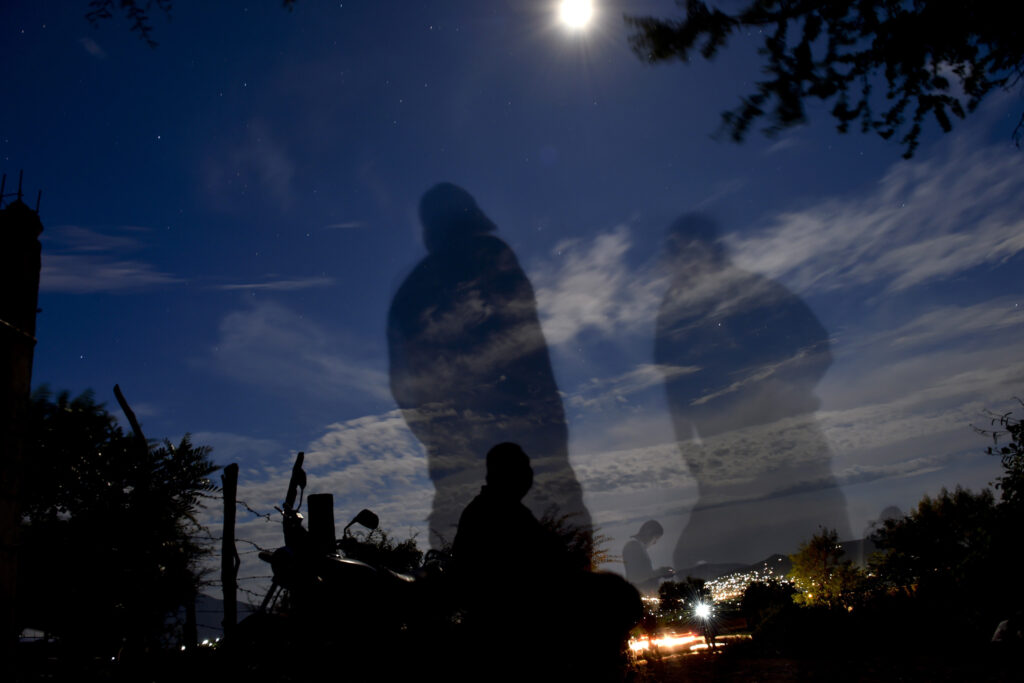Calendars of Truth

On September 26 of this year, the streets of Mexico City once again filled with the faces and the voices of Ayotzinapa. Eleven years after the disappearance of forty-three students, the annual march has become part of a ritual calendar of protest: Names are spoken, banners are carried, justice is invoked. One demand is made—if the students were taken alive, they must be returned alive. “Vivos se los llevaron, vivos los queremos.” To say “they were taken alive” is to insist they might still be alive, suspended in a space where truth has yet to land. Investigations attempt to find that truth, often without resolution. A commission for “truth and access to justice” was established in December 2018 by presidential decree, exclusively dedicated to the Ayotzinapa case. The same demand is repeated. For most, September 26 has become a metronome of remembrance, a rhythm by which a nation counts its failures and measures its inability to face the disappearance not only of those forty-three students, but of the hundreds of thousands of others—most without marches, investigations, or commissions—who have been killed or who have gone missing over the past two decades.
Earlier that month, a UN independent commission—and Mexico’s own president—had called Israel’s campaign in Gaza a genocide. The calendar of the law, local or international, is procedural: It moves through hearings and rulings, through words that aim to gel events into crimes—“enforced disappearance,” “crimes against humanity,” “genocide.” These nouns aspire to tame violence by naming it. The law’s grammar seeks finality, the closure of history. Its aspiration is almost eschatological, with its promise that once a harm is labeled, the world might forever hold still. The law wants to stop time momentarily to address what has been done and prevent the past from repeating itself in the future. Sometimes a ruling brings relief, but even then, its language keeps moving under the surface: searching, yearning, raging, hurting, assessing, doubting.
The same week as the word “genocide” reverberated from podiums and screens, I was also immersed in an older calendar. It was the week of the Yamim Noraim, the Days of Awe in Jewish tradition, when life and death are said to be written and rewritten in the Book of Life. I am not religious, but I am moved by the stories, the rituals, and the gatherings attached to those dates. Those days call on us to reckon with harm: to self, to others, to something beyond. This year, some of the liturgy’s syllables, ones I have rehearsed for as long as I can remember, gathered stagnant in my throat as we reached Yom Kippur, the day of atonement, the time for accountability. The Hebrew Bible offers prayer, and it offers the story of the Hebrew prophet Jonah. I have kept thinking about Jonah.
From the metronome of the disappeared to the tempo of international law’s gavel to the yearly ritual of prayers of repentance—the overlap of these calendars this year led me to ask about the state of truth-telling today. There is not simply a crisis of misinformation, but a deeper rupture in how we imagine what truth does in the world. Each calendar creates a strange interval, and that’s where I live now: wanting the chant to pierce through performance, the sentence to mean more than its syntax, and the prayer to awaken rather than soothe.
Truth is often tethered to redemption or revelation. Name the facts. Uncover the lie. Deliver the data. Speak truth to power. And the truth shall set you free. Whether through liberal legalism, nationalist resistance, or revolutionary transparency, truth is supposed to bend the arc of history toward justice. But what if it doesn’t? What, then, does truth do? And why seek to tell it?
The conversation around truth in recent years has revolved around fake news, algorithmic echo chambers, and the weaponization of propaganda. But beyond the sense of an epistemic collapse, there is the civilizational disintegration of the moral-civic contract—wrapped in education, journalism, activism, and even liturgy—that so many of us implicitly believe in. The idea of truth-as-salvation was never solid, but now, peering into the world’s fractures, we can see how thin that promise has always been.
I’ve found myself especially drawn to three figures to think about the unruly task of truth-telling: Antigone, Cassandra, and Jonah. They are not metaphors so much as frequencies. They don’t speak truth to power in the liberal sense. They don’t hold up facts to the state like mirrors. They are not rewarded for their pronouncements. If anything, they are expelled, dismissed, swallowed up—not only by tyrants, but by time, by myth, by those who prefer coherence to disruption, and by some who want to see truth-tellers stop disrupting and be crowned. Truth-telling does not resolve; it unravels. It complicates truth itself. Truth-tellers are not catalysts for justice or freedom so much as for perception: They recalibrate the world’s moral acoustics, making something audible that wasn’t yet. They don’t resolve what hurts; they reorder what it is possible to hear, to feel, to carry. Truth-tellers hate this. But they know its potency. Not as an aspirational abstraction that has been corrupted, but for how truth moves with the people and the cities—or doesn’t. Not as it raises us to enlightenment, but as it precipitates the collapse of what we expect of it.
Antigone
When I first marched through the streets of Mexico City in 2014—demanding the return alive of the forty-three disappeared students—the air was thick with a different kind of breath. Anger, pain, and possibility mingled with the taste of smoke and corn. My body was younger and hungrier then. We shouted our throats raw. I organized teach-ins at my university, trying to listen without appropriating, to feel grief without centering myself. I didn’t have the language then for what that protest was doing to me. Grief, indignation, and rage landed in my breathing. I could also feel how quickly all this could begin to dissipate for some of us, while for others—those who wager everything they have and do on finding the disappeared—it would remain indefinitely.
The years have passed. I have and haven’t moved on. The urgency I felt then has changed tempo. What once marked a rupture now recurs annually, rhythmically. The forty-three students have become a metonym for over 130,000 disappeared in Mexico. Even the state has organized its own time around them. Commissions, reports, promises. Meanwhile, mothers, sisters, partners, and friends continue to search for mass graves with shovels and their own hands. The state’s announcements have become another ritual postponement. And the protesters chant: “Fue el estado.” It was the state.
The bureaucracy appropriates the grammar of mourning. The political theorist Nazlı Konya, writing about post-coup Turkey, helps explain what I have seen. After the government of Recep Tayyip Erdoğan crushed the Gezi Park protests of 2013, it began organizing nightly vigils that mimicked their aesthetics—with tents, communal meals, songs—transforming the choreography of dissent into a ritual of obedience. Konya writes that what the regime showed through its vigils was envy, not of the protesters’ message, but of their jouissance—the embodied joy of appearing together, beyond the grief and the anger. I think of this when I hear officials in Mexico speak of “truth” and “justice,” hollowing out the chants of the more than two hundred collectives that are still searching for the missing. The state no longer only suppresses the bodies in the street—it seeks to co-opt their rhythm.
In this choreography, mourning is nationalized; in time, it might even become official. The government speaks as if closure has already occurred. But on the ground, mothers and sisters and partners still travel from town to town, losing their jobs and their health, asking questions that have already been answered too many times and never truly once. Their bodies carry time differently.
The chants and the searches echo inside me. They resound in the unfinished stories left across the ocean, tales that haunted those who arrived in Mexico long before I was born and who accompany me now. The stories and the silences recognize one another, especially when I don’t.
This is the time of Antigone.
Antigone was born of catastrophe, daughter of Oedipus and Jocasta, and destined for defiance. When her brother Polyneices dies rebelling against the new order of King Creon’s polis, the king declares that Polyneices’s corpse must remain unburied as a warning to traitors. Antigone disobeys. She covers her brother’s body with soil—an act of exposure. She does not speak truth to power in the way a journalist would; she disturbs its order. She insists on the duties owed to the dead over the laws of the living. Her sister Ismene hesitates, asking Antigone to abide, and a tension forms between the one’s conviction and the other’s caution.
Antigone was a parrhesiastes. The term parrhesia—pan, everything, all; rhema, what is said—was first uttered in Euripides and then repeated through ancient Athenian assemblies, where it joined isegoria, equal speech, as one of democracy’s twin axes. More recently, the French philosopher Michel Foucault redefined parrhesia as an ethical act, explaining it as the virtue of individuals who publicly speak a truth that entails a risk to the self. But in the Athenian assemblies, and even in Foucault’s public world, truth-telling is bounded by the unspoken power of the political orders: It is a practice exclusive to citizens or free men. To think of Antigone as a parrhesiastes contests those understandings and takes us back to parrhesia’s first pulse—to the tremor that opens up speech to touch “all” (or attempts to) and the everything that “all” depends on: our relationships and our sense of belonging, our sustenance, our sense of who we are and how things should be.
The political theorist Bonnie Honig reminds us that Antigone’s power lies not in martyrdom, but in interruption. Burial doesn’t signal closure so much as a refusal to let the city resume its narrative of order. Honig also rehabilitates Ismene, often cast as Antigone’s foil, describing her stance as support, a quiet conspiracy.
“These laws were not made yesterday or today,” Antigone says in Sophocles’s play, “but for all time.” “All time” doesn’t mean eternity. It doesn’t have to. It means for the duration of care, for insistence, and for truths that resist being buried. In our own non-divine and temporary world, “all” can never be said—it is an impossibility in any language, even Antigone’s. As the political theorist and classics scholar Jill Frank writes, Sophocles’s play “calls man to his possibilities and to a recognition of his limitations.” Antigone’s parrhesia exists in motion, between character and setting. So does translation. And so do the madres buscadoras (mothers who search). They dig where the state and the cartels demand silence. They walk with a truth that will not rest.
In Antígonas: Writing from Latin America, the comparative literature scholar Moira Fradinger gathers stories tracing how Antigone has been reimagined across the continent since at least the nineteenth century—not as a solitary Greek martyr, but as a Latin American sister joining the search for the lost. These Antígonas interrupt time through a mourning that refuses to end. They suspend a city’s story and move it outside official narrative. In their defiance, Antígonas are supported by histories, by many shovels, and by Ismenes who shield them with reverence and love. And yet they remain tragically alone, alienated from everything but their quest for truth.

Cassandra
Enforced disappearance is defined as a crime against humanity when a state or political organization arrests or abducts people and then refuses to acknowledge their deprivation of freedom. In Mexico, however, the story is murkier. The protesters who chant “it was the state” in the name of the disappeared point at the perpetrator with certainty. But what is “the state” when mafias, cartels, and government officials often operate in collusion, sometimes indistinguishably?
To name a crime is to make it real—but only in the way that a photograph captures movement by freezing it. Naming is affixing. Recording is containment. Any verdict creates both illumination and sediment: The truth is solidified before it moves again. “Rape.” “Enforced disappearance.” “Genocide.” These words are meant to inscribe torment into the record of history to prevent it from happening again. They carry the promise that, through the act of declaration, chaos will turn into order and injustice into judgment. That crime will be forestalled. “Never again.” The courtroom operates through a speech act: I declare, I pronounce, I sentence.
But truth rarely fits inside a sentence. The gavel is a punctuation mark. The act that acknowledges a reality of suffering also begins to domesticate it. Naming is only one of truth’s temporalities. A date to remember. A file to archive. To name is to give truth a momentary shape, to pause its continual unfolding. Like a rest in music, it makes space for air. But truth moves on, repeating and doubting itself. Naming expires almost as soon as it happens. As Cassandra, another figure of Greek tragedy, knows, truth does not stay still.
Cassandra was not a parrhesiastes but a prophetess, saddled with the knowledge of what would happen yet never to be believed. A princess of Troy, she was both blessed and cursed by Apollo after she refused his advances: He had offered her the gift of prophecy in exchange for satisfying his desire. The line expressing her reneging in Aeschylus’s Agamemnon is often translated as “I consented once to Loxias [Apollo] but deceived him after,” as though it were a confession. Apollo grants her prophecy; she breaks the deal; he curses her.
Cassandra’s words, however, can be read not as a confession of deceit, but as a political naming of coercion. As the classicist and philologist Helene P. Foley argues, Greek tragedy often uses female characters to stand in for significant ethical and political challenges, both exploiting and questioning the clichés of what women represent. In the Greek, ethelon (“I was willing”) and hemartómen (“I failed”) do not explicitly say Cassandra lied; they convey ambivalence, duress, or self-blame. The tone is haunted, not deceitful. When Cassandra says “I was willing once to accept Loxias, but I failed,” she could be describing a moment of pressure—Apollo’s seduction is entrapment—and internal division. Her failure may simply mean: I did not comply.
In this reading, Apollo’s gift of prophecy becomes an act of retaliation disguised as benevolence, and the so-called curse he then attaches to it—condemning Cassandra to always be disbelieved—is his final violence: divine gaslighting. Cassandra didn’t break her promise; she revoked coerced consent. Her only error is refusing to convert herself into the currency of exchange for divine favor.
The feminist classicist, essayist, and poet Anne Carson has spent a lifetime interpreting Aeschylus’s Agamemnon, especially the parts on Cassandra. Cassandra’s punishment for refusing Apollo after he gifts her with foresight is that she will always tell the truth yet no one will ever listen to her. She foresees the fall of Troy, the murder of Agamemnon, her own death. Her truth belongs to a different time altogether: anticipatory, already doomed, and still repeated. She sees the future as if it were memory. As Carson argues, “The arts of prophecy are often tautological. …The prophet must prove to you that she is a prophet by telling you unbelievable news, which you will only believe if you already regard her as a prophet. If the news is not unbelievable then she is just a news source.” In Carson’s terms, “Cassandra float can”—her words are light, her pain is unintelligible, yet her capacity is undeniable.
Cassandra’s speech—she warns the Trojans that the Greeks are hiding in a wooden horse; she even tries to burn it—produces chaos, panic, and interpretation. It is taken as madness and blasphemy. After Troy is consumed by flames, she seeks refuge in Athena’s temple. Ajax drags her from the altar and rapes her. The crime remains hidden until another seer, Calchas, speaks it aloud. Agamemnon then takes Cassandra as a spoil of war. Ajax and Agamemnon enact the violence Cassandra had refused from Apollo. The prophecy turns back on itself. Cassandra also foresees Agamemnon’s and her own death, at the hands of Clytemnestra. The goddess Artemis had demanded that Agamemnon sacrifice his and Clytemnestra’s daughter, Iphigenia, a symbol of purity and bravery. He did. And he went on to destroy Troy. Artemis had granted him the gift of conquest but poisoned it with his own demise.
Cassandra has the foresight to prevent disaster. She is also both a survivor who keeps trying to prove her pain and her own advocate, always dismissed. Cassandra’s curse is to have clarity in a world structured to ignore her, at the world’s peril and her own. She refused to trade her body for the right to speak the truth. She knows about the Trojan horse, and she knows how easily generosity can conceal ruin. Truth was the Trojan horse. The wooden gift enters Troy; Apollo’s gift made its way into her. For Cassandra, time is a closed loop: The truth will be seen one day, but not soon enough to matter, and yet she must speak anyway.
In a recent interview, the writer and columnist M. Gessen spoke with Francesca Albanese, the UN rapporteur for the occupied Palestinian territories. Albanese works to stop atrocities before they harden into history. Hers is Cassandra’s law: tasked with foresight, bound to warning, condemned to repetition. When the warning fails, speech continues—it documents, circles back, and becomes a vision of the same future. The language meant to avert becomes the language that records. Albanese’s reports record what was foreseen, name what was already known, and still witness the unbearable. Simultaneously heard and unheard, believed and dismissed in the same breath. Truth-telling is a trap: to keep speaking even as the speaking confirms the futility of speech. There is no right time for truth. It is always too early and always too late.
Jonah
Antigone’s truth-telling is one for all time. Cassandra’s, of impossible timing. Then there is Jonah’s.
The story’s beginning is deceptively simple: a command, a refusal, a flight. God tells Jonah to go to Nineveh, a city swollen with violence, and proclaim its destruction. Jonah does not argue or debate; he flees. His silence is immediate and instinctive. He is not the only prophet in scripture who resists prophecy: Moses pleads inadequacy, Jeremiah feels unready. But Jonah just runs.
He seeks escape by sea, an element that promises erasure. Yet the sea, in Jonah’s story, is no refuge. When a great storm hits, the sailors cast lots to determine who brought on the calamity and the lot falls on him. He confesses having fled and asks to be thrown overboard. In this moment, Jonah begins to take responsibility for the truth he has heard and refuses. He chooses annihilation over duty.
Enter the whale. The text says only that God appointed a great fish to swallow Jonah. It alters time absolutely. Inside the whale, chronology disintegrates. Those three days and three nights are both finite and endless. Nineveh still sins and the sea still moves. But inside the whale’s entrails, Jonah learns another rhythm: digestion, darkness, the slow circulation of breath in a space where he can declare neither death nor life. A body is processing the truth. Jonah prays, but his prayer is not composed. He connects his mind to his mouth, from the gut. This is time swallowed and truth metabolized.
What Jonah learns in those viscera is something neither the law nor the temple could teach. He, a prophet, a representative of truth, is ingested. Once ingested, he begins to digest what he carries. That ferments and transforms him, and it becomes indistinguishable from his survival. When Jonah is vomited back onto land, on God’s orders, he gives in to prophecy. He walks through Nineveh, speaks just eight words—“Forty more days, and Nineveh will be overthrown.”—and the city repents. The people fast, the king bows, the animals are covered with sackcloth. This might be the most effective prophecy in scripture, and yet the prophet is miserable. Success feels like betrayal. After metabolizing the violence he has to denounce, Jonah wants justice and instead he witnesses mercy. He wants truth to destroy, and it creates.
God asks: “Is it right for you to be angry?” Jonah does not answer. He walks off, finds a place east of the city, and builds a shelter from which to watch the cruel city fall. It never does. A plant grows to shade him, then withers overnight. Jonah’s fury is absurd, and it is true. He has done everything right, and the world remains alive and unjust and merciful. That mercy is unbearable because it exposes the limits of his righteousness. It demands that he live without vindication, exposing the friction inherent to truth-telling, which lives in multiple contradictory dimensions at once. Jonah’s story exposes the distance between truth, justice, and mercy. God’s response to Jonah’s disappointment after he obeys and speaks divine truth is to kill the plant God himself had created, all to teach Jonah a lesson. The plant had hurt no one; it had no such capacity. Jonah’s experience is frustrated—God’s truth is not his own. We don’t ever know what Jonah’s truth is, but we know his experience of his telling it: the running, mulling, waiting, and then, after he finally utters the truth he was supposed to deliver, his deep disappointment. In his staying put, in his witnessing.
Jonah’s truth-telling is neither for all-time nor of impossible timing. It’s about staying in the time of reflection brought on by paradox, in the maddening contradiction of watching an innocent plant be killed and a guilty people be forgiven.
Jonah’s anger is not born of disobedience but of grief for a world that refuses to divide cleanly into right and wrong, reward and punishment. Truth, when spoken, does not necessarily punish; sometimes it forgives. Mercy, which Yom Kippur invites us to yearn for, can be harder to bear than judgment. Jonah is the prophet not of failure but of continuance after violation: the one who learns that bearing the truth is heavy and yet telling it is no relief. God’s truth brings about a world Jonah wanted first to flee and then to destroy, only to survive with no destruction at all, neither the city’s nor his own. This truth is not a resolution but a residue, what remains after conviction has exhausted itself.
Every year, when the forty-three names echo again through the streets of Mexico City, I think of what will come of all the crimes against humanity, named and unnamed, that are perpetrated over and over again. I think of Jonah under his dying plant. He has done the truth-telling, yet the world’s violence persists. He cannot destroy the city, and he cannot leave its walls. He can only sit, watching recreation where he expected ruin. Perhaps that is what it means to inhabit swallowed time: to live with a truth that neither saves nor condemns but that keeps breathing through you, unsettled.
Of all the figures I have returned to, Jonah is the one I have resisted the most. He is no hero, no martyr. He doesn’t want to speak. When he finally does, he regrets it. And yet he may be the figure closest to how I have lived lately, with the burning desire to tell the contradictory truths I feel inside me, not yet spoken nor even digested. They are not a torch I carry, but something I try to outrun yet am pulled to care for.
I think about Jonah when I find myself retreating alone, when I say too little too late, when I am bitter that things change but not on my terms. Jonah is the one who tells the truth and then wishes he hadn’t. He was swallowed by truth and vomited out by it, and still he never quite accepts it.
The belly of the whale holds Jonah in suspension, in neither rebellion nor obedience. It is the space many of us live in: the space between knowing and acting, between seeing and speaking. The whale holds us when we cannot surface.
Jonah’s story is about how truth-telling isn’t always brave, clear, or righteous. Sometimes, it’s not that people won’t listen; it’s that the speaker no longer knows if he wants to speak. He wants to be seen, yet his truth drifts inside the whale’s belly beyond God or the city’s reach. Still, in that darkness, the speaking stirs something. Jonah is the figure for times when speech persists through weariness, when conviction is tangled with resentment, when the truth arrives as a sigh under water.
An Elemental Truth
Experiencing multiple calendars of truth in the span of ten days recently caught me off guard. It pushed me to feel many truths and fear what it would mean to tell them, especially when there is no “it” anyone can state with utter comprehension, certainty, or peace. Truth-telling is like breathing—it begins with the need for air to circulate, in the compulsion to exhale. But what is said cannot be unsaid, and then its journey moves through the many elements of our world. Antigone draws that breath into the ground, burying the unmourned, rooting truth in defiance and dust. Cassandra inhales smoke. Hers is a voice alight, which burns even before the fire in the palace, her prophecy turning to ash as it is spoken. Jonah wants to leave air and inhale water, and he finds a space where air and water coexist: a whale’s belly. These are the elements of prophecy and parrhesia. Not one truth nor one form of telling it, but many forms in which they breathe through all that makes us.
So what is truth’s work? It does not always reveal. It does not always redeem. It rarely saves. It is also almost impossible to ignore once you feel it. It marks. It ruptures. Truth does not live in the clarity of facts alone. It interrupts time’s neat procession. It coils itself inside multiple calendars, inside rituals, inside an absence we cannot quite name or let go of. It breathes through mouths that shouldn’t speak yet still do. It shudders in the grave, in the gaps between perception and reality, in the belly. Sometimes it compels. Sometimes it curses. Sometimes it does nothing at all, or worse, it does the opposite of what we wanted it to do.
The force of truth doesn’t live in the posture of being right, or in the fantasy of speaking from an epistemic high ground. It lives in the attempt to stay honest and perceptive while being implicated and incoherent, while wanting justice and comfort and beauty and safety and compassion all at once. It lives in being absorbed and compelled, in slowing time as we are eaten up by tombs, palaces, and whales.
There are truths we cannot prove. Some I cannot even utter and don’t know if I ever will. But we feel them as we carry them in our bodies, like stories that ache without beginning or end. I carry Antigone, not as divine law, but as someone who walks with the memory of those refused burial, whose letters stopped arriving across the sea, whose absence is its own kind of truth. I carry Cassandra, who sees too much and is punished for it, who sees over and over again that which she fought to prevent. I carry Jonah, who spoke and stayed bitter, who endured even when the fulfillment of his prophecy betrayed his intention. I cannot always tell what truth does. But I know it lives between history and prophecy, between exposure and communion, between what we name, what we feel compelled to repeat, what we want, and what we can only barely grasp. Truth doesn’t always liberate; it asks something of us. Not precision, but care and attention. And in that I believe.
Tessy Schlosser is a political theorist and director general of the Mexican Jewish Documentation and Research Center (CDIJUM) in Mexico City.



